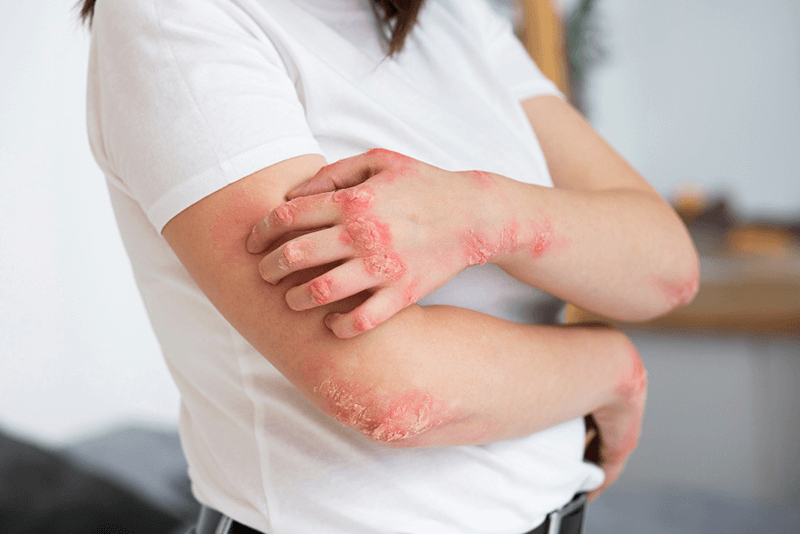Dermatology is a more complex specialty than many others when it comes to reporting diagnosis and management, and many providers rely on medical coding and billing outsourcing companies to do so. According to the National Psoriasis Foundation, psoriasis is the most prevalent autoimmune disease in the U.S. and affects about 7.5 million Americans. Phototherapy is considered one the safest and most cost-effective treatments for psoriasis and many other skin conditions. Proper documentation and complete and compliant coding is critical to quality reporting and provider reimbursement.
About Psoriasis
A chronic skin disease, psoriasis affects multiple body systems, and mainly the skin and the joints. It causes rapid buildup of skin cells which result in scaling on the surface of the skin. Common symptoms include inflammation and redness around the scales. Psoriatic scales may progress into thick, red patches and in some cases, the patches will crack and bleed. Psoriasis can affect the hands, feet, face and/or genital regions. The severity of psoriasis depends how much body surface area and which body parts are affected. Severe skin disease can make daily living difficult and impact quality of life.
Psoriasis presents in different ways, with psoriasis vulgaris being the most common form. Other subtypes of this disease include flexural psoriasis, guttate psoriasis, erythrodermic psoriasis, generalized pustular psoriasis, palmoplantar psoriasis, and psoriasis that affects specific body sites such as the scalp and nails.
Treating Psoriasis
Several conventional treatment modalities are used to treat psoriasis such as:
- topical application of steroids or other drugs
- ultraviolet light (actinotherapy)
- coal tar alone or in combination with ultraviolet Blight (Goeckerman treatment)
- Vitamin D analogues (e.g., calcipotriol and calcitriol), tazarotene, and anthralin.
A newer treatment is psoralen derivative drug in combination with ultraviolet light or PUVA therapy. The American Academy of Dermatology does not support phototherapy for patients with mild localized psoriasis whose disease can be controlled with topical medications.
ICD-10 Coding for Psoriasis
Compared to ICD-9, the ICD-10 codes for psoriasis are driven by increased specificity. While 696.1 was only code in ICD-9, there are multiple ICD-10 codes for psoriasis and its numerous subtypes under the category L40, that is:
Primary category: L (0-99, for diseases of the skin and subcutaneous tissue)
2-digit category: 40 (Psoriasis)
- L40.0 Psoriasis vulgaris
- L40.1 Generalized pustular psoriasis
- L40.2 Acrodermatitis continua
- L40.3 Pustulosispalmariserplantaris
- L40.4 Guttate psoriasis
- L40.5 Psoriasis, other
- L40.50 Arthropathic psoriasis, unspecified
- L40.51 Distal interphalangeal psoriatic arthropathy
- L40.52 Psoriatic arthritis mutilans
- L40.53 Psoriatic spondylitis
- L40.54 Psoriatic juvenile arthropathy
- L40.59 Other psoriatic arthropathy
- L40.8 Other psoriasis
- L40.9 Psoriasis, unspecified
- L41 Parapsoriasis
- L41.0 Pityriasislichenoidesetvarioliformisacuta
- L41.1 Pityriasislichenoideschronica
- L41.3 Small plaque parapsoriasis
- L41.4 Large plaque parapsoriasis
- L41.5 Retiformparapsoriasis
- L41.8 Otherparapsoriasis
- L41.9 Parapsoriasis, unspecified
CPT Codes for Phototherapy
According to an article published in MDedge in July 2017, phototherapy is one of the safest and most cost-effective treatments for psoriasis and other dermatoses. Both UVA and UVB light could help in reducing symptoms of mild to moderate psoriasis. Insurers may provide coverage for PUVA used to treat intractable, disabling psoriasis, on the condition that the psoriasis has not responded to more conventional treatment. Providers who offer phototherapy services for psoriasis should know payer policies and the relevant CPT codes. The MDedge report lists the CPT codes for reporting phototherapy services as follows:
- 96900 Actinotherapy (UV light treatment)
- 96910 Photochemotherapy, tar, and UVB (Goeckerman treatment) or petrolatum and UVB
- 96912 Photochemotherapy and PUVA
- 96913 Photochemotherapy (Goeckerman and/or PUVA) for severe photoresponsivedermatoses requiring at least 4 to 8 hours of care under direct supervision of the physician
Points to Note when Reporting Phototherapy Services for Psoriasis
- The MDedge article highlights that actinotherapy (96900) defines the basic service of treating a patient with a UV light unit, and does not involve application of topical medications while the patient is in the office.
- On the other hand, as a www.daavlin.com report points out, photochemotherapy (96910) and photochemotherapy and PUVA (96912) mean that the light treatments are given in conjunction with mineral oil, tar or the photosensitizing drug, Psoralen. According to the MDedge report, if the application of topical photo enhancing products occurs outside the office, the requirements of photochemotherapy are not met, and 96900 should be reported.
- When billing 96910, the documentation should include a contemporaneous note stating that mineral oil was applied with the direct involvement of a clinical staff member. The staff member should be identified in the note. “Contemporaneous” means that the provider should document this each and every time a treatment is given.
- Code 96913 code defines prolonged phototherapy service with intensive topical therapy requirements and multiple phototherapy sessions per day.
- Providers have specific coverage rules. For instance, Blue Cross Blue Shield BCBS) of North Carolina may consider PUVA as medically necessary for the treatment of Severe, disabling psoriasis, which is not responsive to other forms of conservative therapy (e.g., topical corticosteroids, coal/tar preparations, and ultraviolet light). BCBS of North Carolina also states that they may consider targeted phototherapy as medically necessary for the treatment of the following conditions:
- Moderate to severe psoriasis (comprising less than 20% body area) for which NB-UVBor PUVA are indicated
- Mild to moderate localized psoriasis that is unresponsive to conservative treatment
BCBS of North Carolina considers targeted phototherapy as investigational for conditions not addressed as medically necessary, for e.g., first-line treatment of mild psoriasis and generalized psoriasis or psoriatic arthritis.
- For Medicare Plan members, providers should reference the Applicable National Coverage Determinations(NCD) and Local Coverage Determinations (LCD) and ensure where applicable.
Private insurer as well as Medicare audits of medical records for phototherapy services has increased. Detailed and accurate documentation is necessary to avoid scrutiny. Partnering with an experienced dermatology medical billing and coding company can help ensure error-free reporting of phototherapy services for psoriasis for optimal reimbursement.




